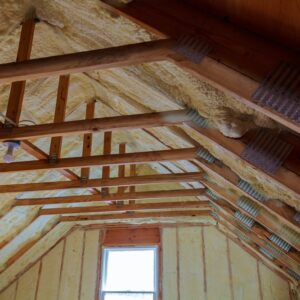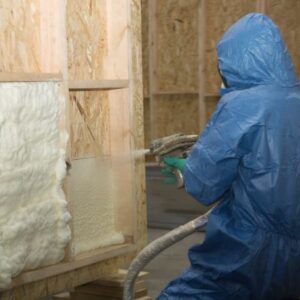Why Loft Insulation?
A quarter of heat is lost through the roof in an uninsulated home. Insulating your loft, attic or flat roof is an effective way to reduce heat loss and reduce your heating bills.
Installed correctly, loft insulation should pay for itself many times over in its 40-year lifetime.
Pipes, water tank and loft hatch
Insulating between the joists of your loft will keep your house warmer, but make the roof space above colder.
This means pipes and water tanks in the loft space could be more likely to freeze, so we will need to insulate them. If your water tank is some distance from the loft hatch, you will also need something to walk on for safe access.
The cooler air in your insulated loft could mean that cold draughts come through the loft hatch. To prevent this, we fit an insulated loft hatch and put strips of draught-excluding material around the hatch edges.
Choosing Loft Insulation
If your loft is easy to access and has no damp or condensation problems, it should be easy to insulate.
If access is easy and your loft joists are regular, we can use rolls of mineral wool insulation. The first layer is laid between the joists – the horizontal beams that make up the floor of the loft – then another layer is laid at right angles to cover the joists and make the insulation up to the required depth.
In Conclusion
The benefits of insulating your loft properly should be pretty clear by now. It’s worth remembering that even if you have insulation already it’s a good idea to either check that yourself or get someone to check it for you. Insulation should be at least 270mm thick, shouldn’t be squashed at all, and if there’s boarding above it there should be a gap for airflow. Poorly installed insulation can cause a heap of problems so get yours checked today!
Get In Touch!
Contact us today to discuss your next project. Upon submitting your details, one of our team will be in touch. Alternatively, call us on 0740 460 9794 or email us at admin@fastwayconstructions.co.uk.
Explore Further
Things to consider when installing loft insulation
Storage Space
If you plan to use the loft or attic for storage, we will be sure to lay boards over the joists. Unfortunately, if you only insulate between the joists before doing this, the insulation won’t be thick enough.
To get enough insulation, we can raise the level of the floor so we can fit enough mineral wool beneath the new floor level. We can do this by fitting timber battens across the joists, or we can buy purpose-built plastic legs that fit on the joists and support the new floor. It’s important to leave a ventilated air gap between the insulation and the boards to prevent condensation on the underside of the boards.
We make sure not to squash the mineral wool when we fit the boards on top, as this will reduce its insulation value.
Damp Lofts
Insulation stops heat escaping from living spaces, so it will make your loft space cooler, which could introduce or worsen existing damp or condensation problems. When we are installing loft insulation, we keep in mind that it may be necessary to increase ventilation.
It’s critical to fix any damp problems first before installing loft insulation.
Warm Lofts
An alternative way to insulate your loft is to fit rigid insulation boards between and over the rafters. Rafters are the sloping timbers that make up the roof itself. This isn’t a DIY job, so you’ll need a specialist professional to insulate your roof.
Advantages:
- The roof space will be warmer than with standard loft insulation, so you won’t need to worry so much about freezing tanks and pipes.
- You can board the floor for storage without having to raise it to create extra depth.
Disadvantages:
- Insulating at rafter level is much more expensive than most standard loft insulation.
- As well as insulating the roof, you will have to insulate any gable walls, party walls and chimneys in the loft space. If you leave these uninsulated, then the heat will bypass your new insulation making it ineffective.
- Insulating at rafter level is fundamentally less efficient than insulating the loft floor. This is because you’ll need to heat a larger volume of air (the air in the loft as well as the air in the rest of the house) and you’ll have a larger surface area losing heat to the outside.
Some companies may offer to fix your damaged or leaking roof by spraying foam insulation directly onto the underside of the roof without fixing the problem first. We don’t recommend that you do this.
As with any type of insulation, we make sure that the roof is dry and in good condition before adding any insulation. Also, right now many mortgage companies aren’t willing to offer loans for properties with foam insulation in the roof, which can make it very difficult to sell a property with this type of insulation.
If you want to turn your loft into a heated, useable room, then we need to take a slightly different approach and carry out a loft conversion to create a room in the roof.
Room in Loft
If you want to use your loft as a living space, or it is already being used as a living space, then we need to make sure that all the walls and ceilings between a heated room and an unheated space are insulated.
- Sloping ceilings can be insulated in the same way as for a warm roof, but with a layer of plasterboard on the inside of the insulation.
- Vertical walls can be insulated in the same way.
- Flat ceilings can be insulated like a standard loft.
We will make sure to insulate all the areas of wall and ceiling round any dormer window, and that we use high performance glazing for the window, or for any skylights.
As with warm loft insulation, this is not a DIY job. Careful work needs to be done by a professional to ensure that the insulation is appropriate and complete, and that adequate ventilation is provided where needed. This is where Fastway Construction can help as experts in loft insulation.
Ventilation
Air needs to flow in and out of your house so it stays fresh, dry and healthy. At Fastway Construction we make sure sure not to block or seal any intentional ventilation, such as vents, grilles or airbricks.
Inaccessible Loft Space
If your loft is hard to access, we can have blown insulation installed. Specialist equipment will be used to blow appropriate insulation material into any awkward space. They may use mineral wool fibre, treated cellulose or polyurethane foam.
Flat Roofs
A flat roof should preferably be insulated from above. A layer of rigid insulation board can be added either on top of the roof’s weatherproof layer or directly on top of the timber roof surface, with a new weatherproof layer on top of the insulation. This is best done when the roof covering needs replacing anyway. If your flat roof needs to be replaced anyway, you must now insulate it to comply with building regulations.
It is possible to insulate a flat roof from underneath, but this can lead to condensation problems if not completed correctly.
Installing flat roof insulation could save you similar amounts on your heating bills to loft insulation. The savings will vary depending on how much of the property has a flat roof.






